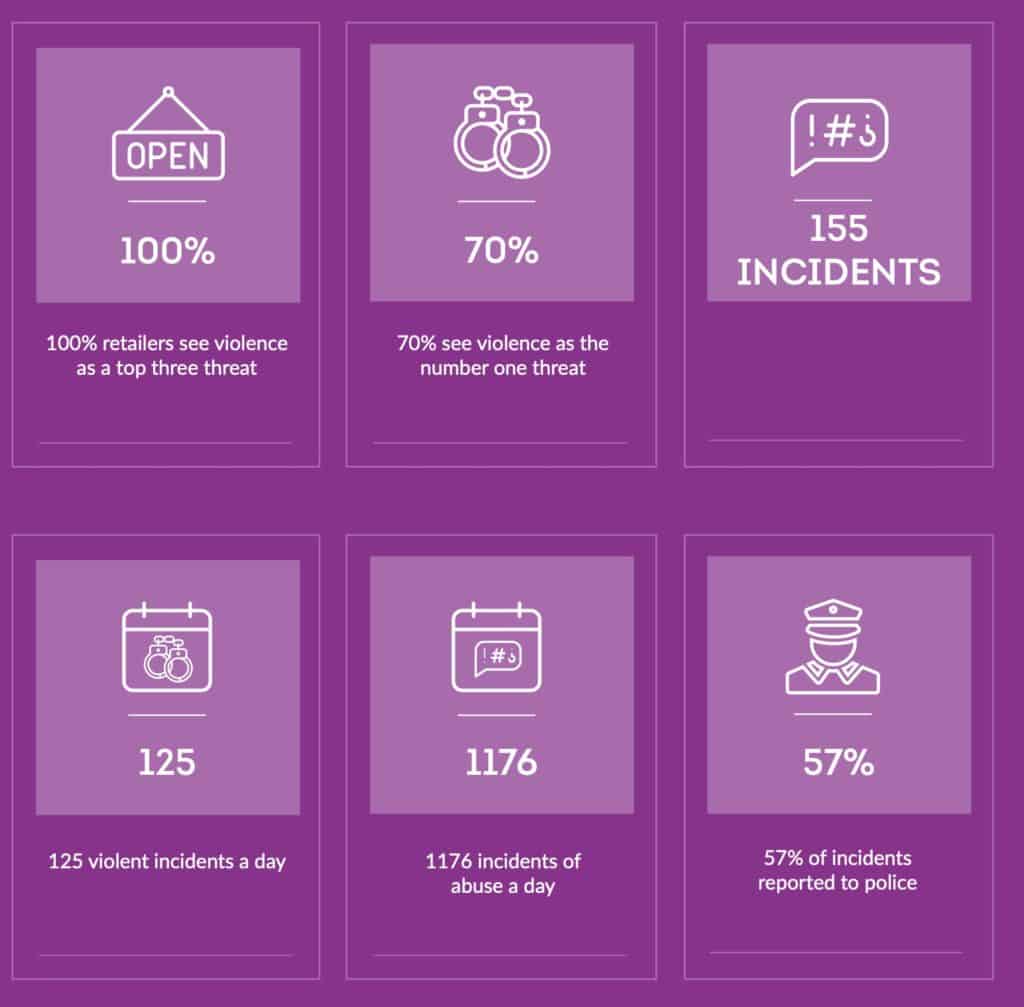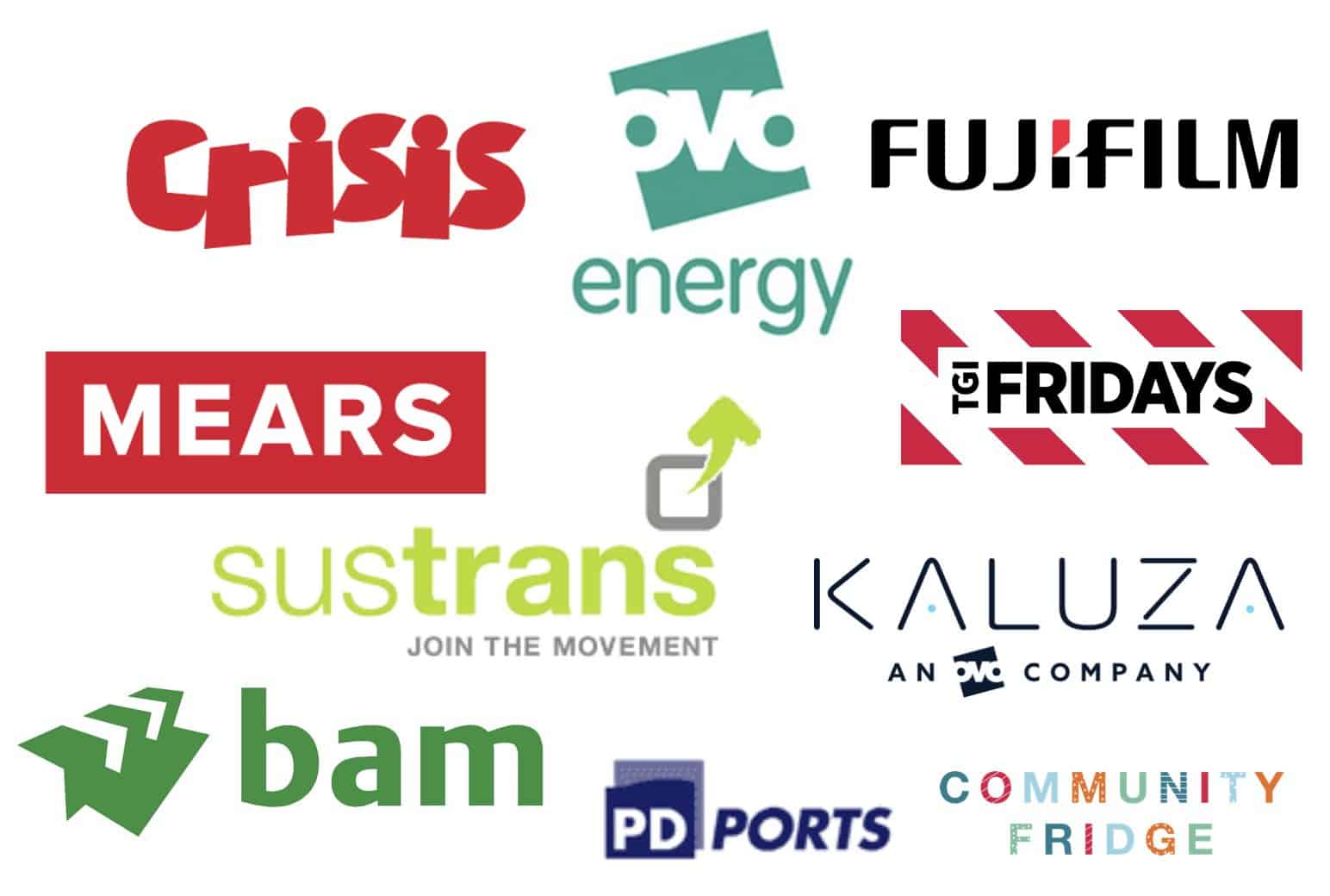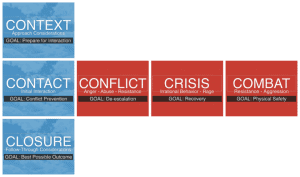Conflict Management for Retail Staff
Training in Conflict Management for Retail Staff -
identify, prevent and deal with conflict professionally.
Training in Conflict Management for Retail Staff
Research from the British Retail Consortium shows that retailers are most concerned about
- Violence against staff
- Theft by customers
- Verbal Abuse against staff
- Robbery
- Anti-Social Behaviour
Conflict Management Training for Retail ensures staff are:
- Treating people with dignity by showing them respect
- Gaining Voluntary Collaboration, Cooperation or Compliance
- Creating an atmosphere of Non-Escalation by tackling Gateway Behaviors
- Initiating Contact Consistently and then applying Empathy and Persuasion
- Responding appropriately in high-risk situations.


Conflict Management for Retail Staff:
reducing Violence Risk in shops and leisure
This course is based on Health And Safety Executive INDG423 and HSG133 advice and guidance, to ensure compliance with best-practice in compliance with legal requirements.
Learning Outcomes for
Conflict Management for Retail Staff
At the end of the proposed training programme, staff will:
Know
– What is meant by ‘Violence at Work’
– What is meant by ‘Theft’ in a retail context
– Your organisation’s policy* on dealing with key issues (theft, ASB, robbery)
– The objectives of Non-Escalation and De-Escalation of Conflict
– The Principles of Reasonable Force
Understand
– what staff Duty of Care is and is not (focus on issues of theft, ASB, robbery)
– the impact that Alcohol, Drugs and the use of Weapons have on situational risk
– Your* (or recommended) procedures for dealing with retail theft
– Your* (or recommended) procedures for dealing with robbery
– the principles of Necessity and Proportionality in using force for self-protection
Do
– practice the target verbal skills in not escalating conflict
– practice how to approach a suspected shoplifter safely
– practice the target verbal skills in dealing with verbal abuse and intimidation
– how and when to withdraw from potentially dangerous or violent situations
– practice the target verbal skills in de-escalating conflict or crisis
– practice how to approach someone presenting anti-social behaviour safely
– practice the target verbal skills in persuasion and influence
– how to physically protect oneself from assault (fundamentals)
*research shows that the best violence management training is closely aligned with the organisation’s own policies and procedures.
TRAINING DELIVERY
The standout features of our Conflict Management for Retail Staff training is that it is Practice-based and Performance-focussed – your teams will be up and moving in the training room, exploring scenarios and contexts which are relevant to their work and our training demands that they produce the words, behaviours and strategies in-vivo, in the classroom, so that they retain them better when they go back to their workplace.
You can see a video from the British Retail Consortium which covers the absolute fundamentals of retail conflict management:
Our learners have included customer service representatives from energy companies (Ovo Energy and Kaluza) and financial services (Black Horse Auto-Leasing) in addition to Crisis charity shops, TGI Fridays restaurants and teams from other retailers around the country.
YOUR TRAINER: Dynamis is an Institute of Conflict Management-accredited Quality Award Centre #2201
Our trainers have a minimum of the following:
- BTEC Level 3 PTTLLS Preparing to Teach for Lifelong Learning education qualification
- BTEC Level 3 Advanced Self-Defence Instructor Qualification
- BTEC Level 3 Conflict Management Qualification
An Evidence-Based Contextual Training Approach
With the help of academic colleagues at Loughborough University, we are continually developing enhanced learning design methodology which ensures that your training budget is spent on best-value activities.
Our training is therefore:
EMOTIONALLY SAFE
delivered in a supportive environment where effort and engagement are rewarded and in which failure is seen as a necessary step towards mastery of target content.
CONTEXTUALISED TO WORKPLACE SCENARIOS
focuses on exploring the complete picture of the most common flashpoint scenarios which are familiar to your team’s experience of the workplace.
FULL-SPECTRUM OF APPROPRIATE RESPONSES
incorporates positional, non-verbal, verbal, emotional, mental and physical attitudes required for a successful, professional response.
PERFORMANCE-ORIENTED
your learners perform the target skills, often in the face of designed-in, desirable difficulties and receive immediate, objective feedback to improve their performance.
Conflict Training for Your Team, Your Context
This conflict management training course is suitable for front-line staff who are in regular contact with members of the public and service users who may become frustrated, upset or aggressive. This training focusses on verbal and non-verbal conflict communications used to manage and de-escalate aggression and distress effectively.
When: Full-Day or 2-Day sessions on a date scheduled for your convenience
Who: up to 16 staff are led by one of our Vistelar-trained, “Verbal Defense and Influence” Conflict Coaches.
What Roles? Any public-facing role or contact-professional within your retail organisation who has responsibility for interacting with, influence, persuading or de-escalating your customers will benefit from training to help you to create a safe and secure environment in your workplaces.
Where: At a venue of your choice, or at your service/business training centre
How: Our trainers deliver this course using a mix of lecture/presentation, Q&A, physical practice and scenario rehearsal using an “Emotionally Safe, Performance-driven Training Environment”
Why Choose this Course?
✓ Matched to your Conflict, Risk and Violence Reduction Skills needs
✓ Led by Professional Conflict, Risk and Violence Reduction Skills Trainers
✓ Values Dignity and Respect as part of a ‘Dignity at Work’ approach
✓ Safeguards Customer rights in conflict situations
✓ Offers Staff Practical Options using Templates for Conflict Communications
✓ Compliant with Government Regulations on Risk Reduction
✓ Value for Your Conflict Management Investment
The experts at Vistelar have been studying how to effectively manage conflict for over 30 years and, during that time, they have developed a framework that provides a means to analyze interactions and determine which conflict management tactic should be used in which phase of an interaction.
Here is a graphic representation of this framework:

The blue boxes in this graphic describe the three elements of all interactions:
- Context: Approach considerations prior to an interaction, such as assessment of risk and physical positioning, decision on whether to proceed and personal mindset.
- Contact: Interaction considerations, such as words used, tone of voice, facial expressions, eye contact, hand position, body language and posture.
- Closure: Follow-through considerations, such as ensuring the situation is stabilized, summarizing decisions, and reviewing the interaction.The primary goals of these elements are non-escalation (conflict prevention), achieving the best possible outcome and establishing a positive foundation for any future interactions.The red boxes in the graphic describe what can happen when interactions escalate:
- Conflict: When questioning, anger or verbal abuse enters into an interaction.
- Crisis: When the person with whom you are interacting is displaying at-risk behaviors.
- Combat: When resistance or aggression results in physical engagement initiated by either party.Note: while uncomfortable to some, the term “Combat” is used as a means to emphasize that physical engagement is a possibility in all jobs and must not be glossed over in conflict management training.The primary goals of these elements are de-escalation, everyone’s safety, and shifting the situation to a positive outcome.In other words, once an interaction escalates to any of the red box elements, the objective is to return things to a place where the blue box elements are driving the interaction.Note that all interactions have a Context, Contact and Closure element but only some interactions escalate to Conflict, Crisis and/or Combat.
Scenarios: Youth Anti-social behaviour, non-payment and retail abuse...
Conflict Management for Retail
We teach your staff how to “Treat People with Dignity by Showing them Respect” and how to “Generate Voluntary Collaboration, Cooperation or Compliance” when they deal with your customers. Here are the learning objectives for Dynamis core Non-Escalation and De-Escalation conflict management curriculum from Vistelar.
By the end of this Conflict and Violence Risk Reduction training program your staff will have the knowledge to interact with customers and to manage conflict professionally by:
- Not cause or unnecessarily escalate conflict
- Confidently deal with verbal abuse
- Engage in difficult conversations
- Effectively de-escalate conflict
- Persuade others to cooperate
- Stay safe in crisis situations
- Know what to do when word-based tactics fail
- End an interaction in a better place than where it started
- Look good on camera no matter where an interaction ends up
“The biggest cause for concern in the report’s findings is the prevalence of violence and abuse against retailers and store colleagues. People working in convenience stores are most vulnerable to violence when they are being responsible members of their community by challenging shop thieves, enforcing age restrictions or refusing to serve intoxicated customers.
Retail crime is not victimless – its impact on the people running, working in and using local shops is lasting, tangible and profound. Everyone connected with our sector, with law enforcement and with the treatment of offenders can play a part in tackling this problem”
- Retailers perceive that 50% of repeat offenders are motivated by a drug or alcohol addiction.
- 83% of staff in convenience stores have experienced verbal abuse.
- Estimated number of violent incidents is 9,782 with 41% of violent incidents result in injury.
- 48% of retailers have experienced violence or verbal abuse.
- 27% of retailers say they have seen an increase in incidents
For more information see the ACS Crime Report (linked) and this VICE article.
Here is the British Retail Consortium Crime report.
We focus on the “tactics” of a conflict management encounter: the meshing of the non-verbal, verbal and physical techniques – the continuum of options that exist in any interaction – to deliver the best outcome.
In other words, we emphasise the application of techniques across the spectrum of conflict — the “Six Cs of Communications” (see list below) — using a level of intrusiveness appropriate for each technique being applied.
1. Context: the approach considerations and initial assessment of the interaction focussing on being prepared for success
2. Contact: how to make an initial contact that doesn’t escalate a situation and is focused on treating others with dignity by showing them respect
3. Conflict: how to stay safe and prevent disagreements from progressing to emotional or physical violence
4. Crisis: how to stay safe and de-escalate a situation when the subject is apparently under the influence of personal stress, drugs & alcohol, or mental health issues.
5. Combat: how to apply the appropriate personal protection and physical control tactics to stabilise a situation when words alone fail.
6. Closure: how to normalise a situation after an incident, which includes reassuring the subject, providing medical treatment and debriefing the incident.
This “tactics” approach to training includes “skill-station” drills – where numerous techniques are applied together in real-world scenarios – which allows the delivery of training in short modules.
See also: https://www.dynamis.training/keeping-retail-staff-safe-from-abuse-intimidation-violence/


